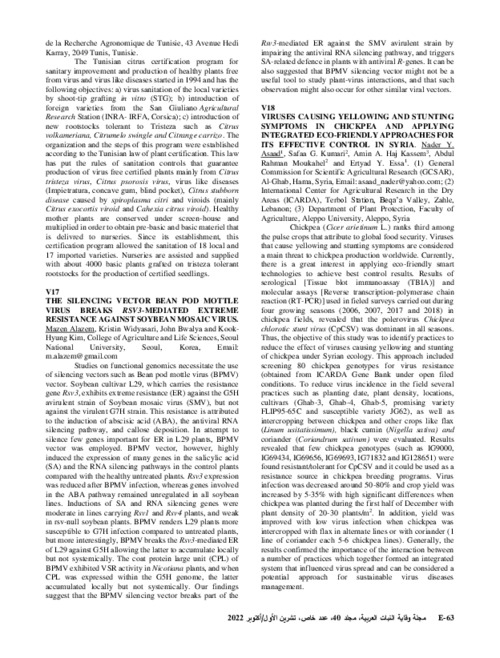Viruses causing yellowing and stunting symptoms in chickpea and applying integrated eco-friendly approaches for its effective control in Syria
Abstract
Chickpea (Cicer arietinum L.) ranks third among the pulse crops that attribute to global food security. Viruses that cause yellowing and stunting symptoms are considered a main threat to chickpea production worldwide. Currently, there is a great interest in applying eco-friendly smart technologies to achieve best control results. Results of serological (Tissue blot immunoassay (TBIA)) and molecular assays (Reverse transcription-polymerase chain reaction (RT-PCR)) used in field surveys carried out during four growing seasons (2006, 2007, 2017 and 2018) in chickpea fields, revealed that the polerovirus Chickpea chlorotic stunt virus (CpCSV) was dominant in all seasons. Thus, the objective of this study was to identify practices to reduce the effect of viruses causing yellowing and stunting of chickpea under Syrian ecology. This approach included screening 80 chickpea genotypes for virus resistance (obtained from ICARDA Gene Bank under open filed conditions. To reduce virus incidence in the field several practices such as planting date, plant density, locations, cultivars (Ghab-3, Ghab-4, Ghab-5, promising variety FLIP95-65C and susceptible variety JG62), as well as intercropping between chickpea and other crops like flax (Linum usitatissimum), black cumin (Nigella sativa) and coriander (Coriandrum sativum) were evaluated. Results revealed that few chickpea genotypes (such as IG9000, IG69434, IG69656, IG69693, IG71832 and IG128651) were found resistant/tolerant for CpCSV and it could be used as a resistance source in chickpea breeding programs. Virus infection was decreased around 50-80% and crop yield was increased by 5-35% with high significant differences when chickpea was planted during the first half of December with plant density of 20-30 plants/m2. In addition, yield was improved with low virus infection when chickpea was intercropped with flax in alternate lines or with coriander (1 line of coriander each 5-6 chickpea lines). Generally, the results confirmed the importance of the interaction between a number of practices which together formed an integrated system that influenced virus spread and can be considered a potential approach for sustainable virus diseases management

